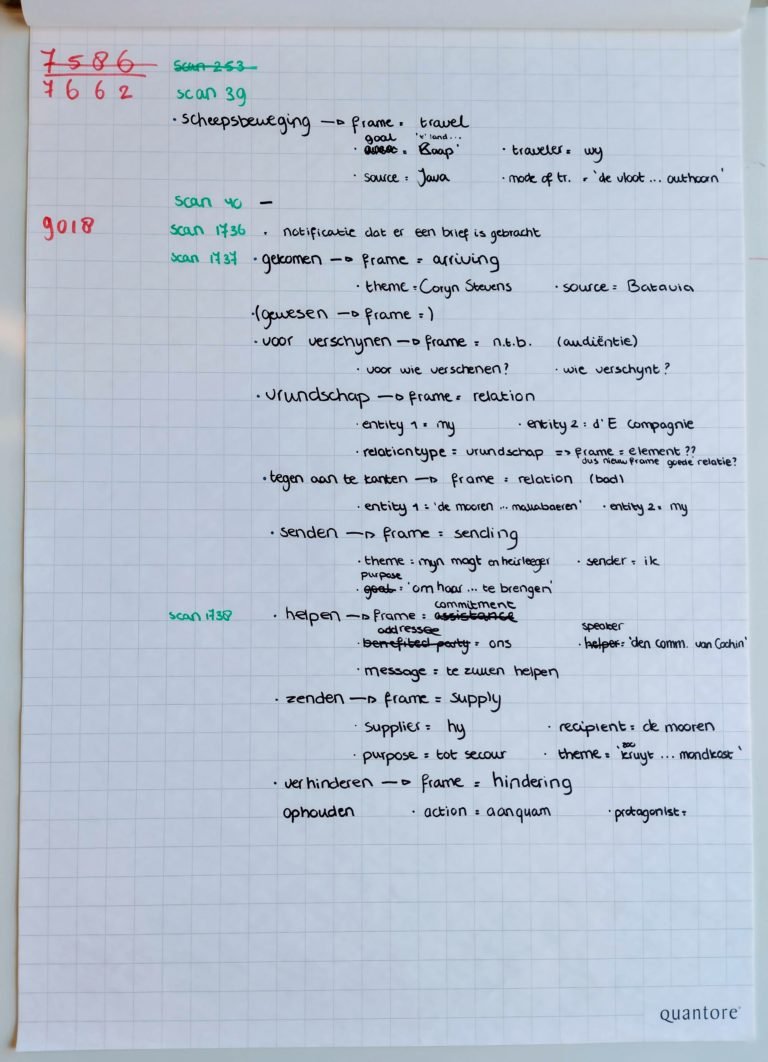Introduction
The Dutch East India Company (VOC) records are in the Nationaal Archief Den Haag, under the number 1.04.02. These trading company records span two centuries and cover a wide range of maritime Asia as well as the Cape of Good Hope. In addition to information pertaining to commercial activities of the company, this rich resource also provides glimpses into interactions between the VOC, political powers and communities across these regions. An introduction in English by F. S. Gaastra provides more detailed guidance on these archives.
The GLOBALISE corpus comprises of Overgekomen Brieven en Papieren (Received Letters and Papers) inventory numbers 1053-4454 and 7527-11024. GLOBALISE’s Transcriptions Viewer enables searching through the HTR results of approximately 5 million scans of these records. The infrastructure aims to facilitate research around key themes. Possibilities includes tracing the movements of individuals, objects, and ideas across regions, as well as explorations into new themes that were previously not as easily searchable through analogue means. This guide provides examples of typical search queries. If you have a new question, feel free to reach out to us!
Before you begin
Read our help page for practical tips on how to search the corpus using keywords and wildcards. Do keep the following points in mind.
Transcription errors
These transcriptions have not been individually and manually verified. A search may return unexpected results, or expected results may not appear. If secondary literature confirms that the record exists within the GLOBALISE corpus, but the record cannot be found using a simple keyword search, try out combinations of keywords related to your topic.
Historical and variant spellings
Use historical terms and be aware of variant spellings. For example, searching for ‘nootmuskaat’ will not return a single search result, because ‘nootmuskaat’ is a modern Dutch word. Instead, use historical terms such as ‘noten’, ‘muskaat’, or ‘folie’.
Helpful references to have on hand include the historical dictionary of old Dutch and the VOC glossarium. Relevant historical terms may also be found in our datasets and thesaurus of commodities.
Interpreting search results
The Transcriptions Viewer currently has limited functionality to order or filter the search result. The order of search results is determined by the highest number of matching hits per individual scan page. A scan page with 10 hits will be ranked above a scan page with 8 hits. Currently, every scan page is searched individually, as the results are not yet stacked. You may come across a different scan page from the same document, or from the same inventory number, much later in the list of search results.
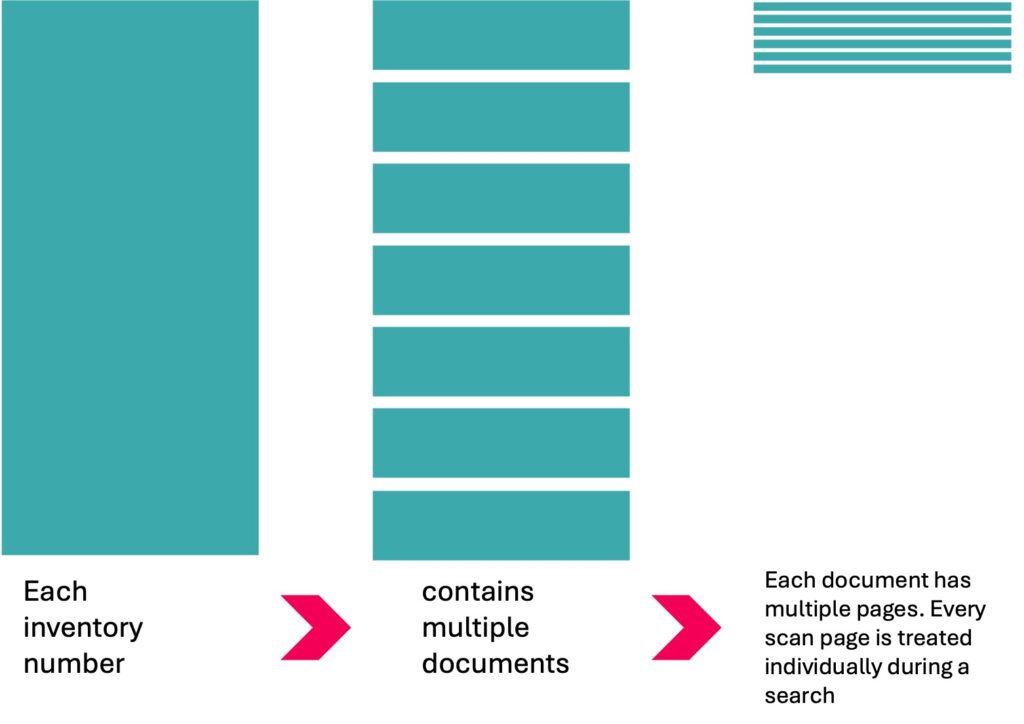
Because of this, it is not enough to view only the first few pages of search results, as relevant information may be found much further down the list. These search results are out of context. Interpreting search results requires further contextualisation using other historical sources. When a search query yields a very large number of results, try to develop a general ‘sense’ of inventory numbers which seem to be recurring, also note the geography or the time period that may appear relevant. Then try out keywords using ‘AND’ combined with geography or time markers, to further direct your search queries.
Information about each scan page
On any page, click on the three lines on the sidebar to the left to display metadata for each scan. This shows the year and location from where the document was sent. In the example below, the inventory number 1616 is dated 1700 and comes from Ceylon (present-day Sri Lanka). The permalink leads back to the Nationaal Archief website, where the high-resolution image is available for download.

Click on the third icon to browse through all scans in the same inventory number in order.
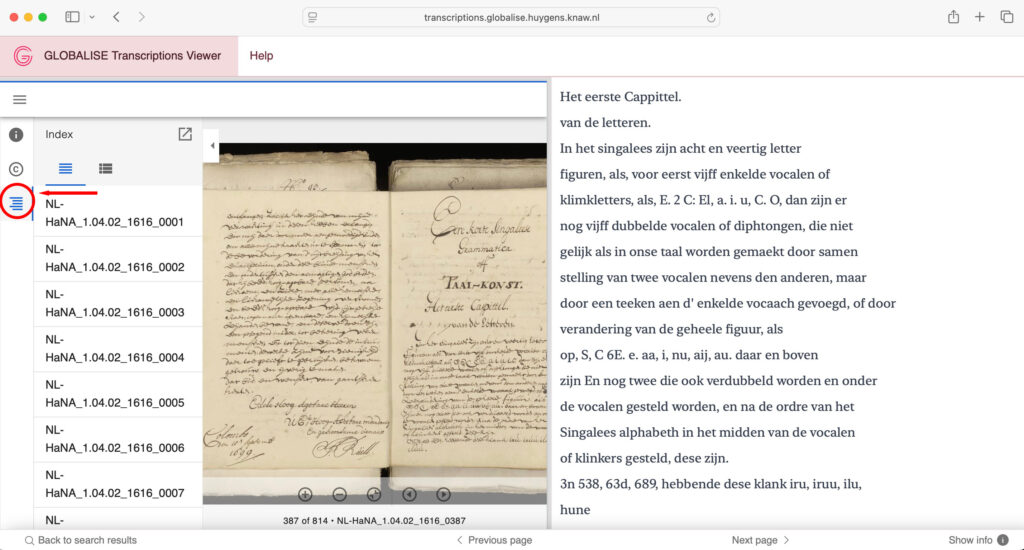
Using the image viewer
Clicking back and forth on the arrows in the image viewer (1) does not automatically load corresponding transcriptions on the right.
Instead, click on < previous page or next page > (2) on the navigation bar at the bottom to turn both the transcription page and the image.
In fact, this disconnect can be useful to browse and locate specific pages in the same volume. First, load the contents page of an inventory number, in this case 2559. Make sure the corresponding transcription is displayed on the right. Next, click the sidebar (3) to display the list of scans in the same inventory number.
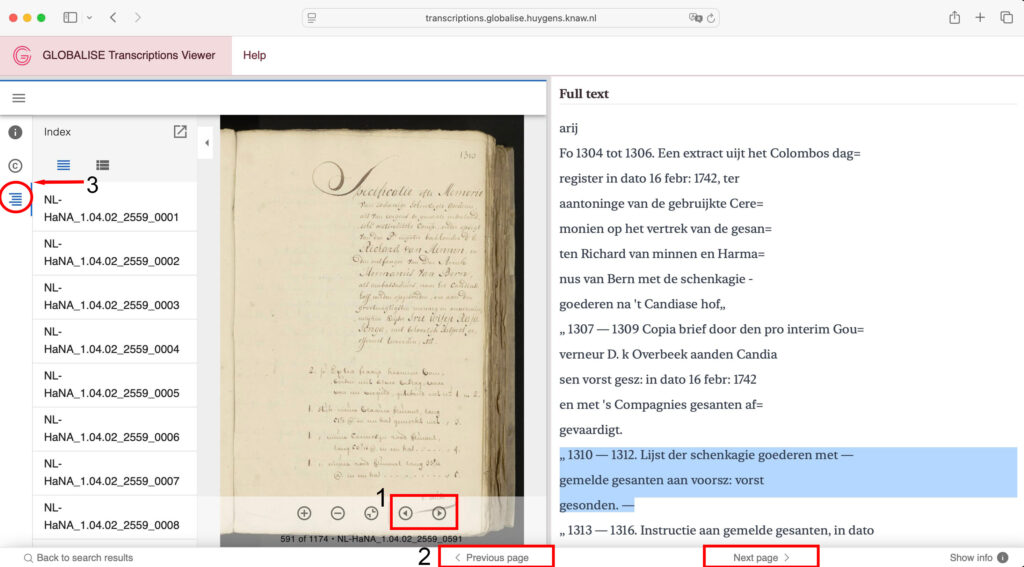
In this example, we are looking for a list of gifts on folio 1310. We can click down the list of scans to find the required page. This action does not automatically load corresponding transcriptions on the right. This is a fast way to navigate the volume, while still having the contents page open on the right. In this case, folio 1310 turns out to be scan number 591.
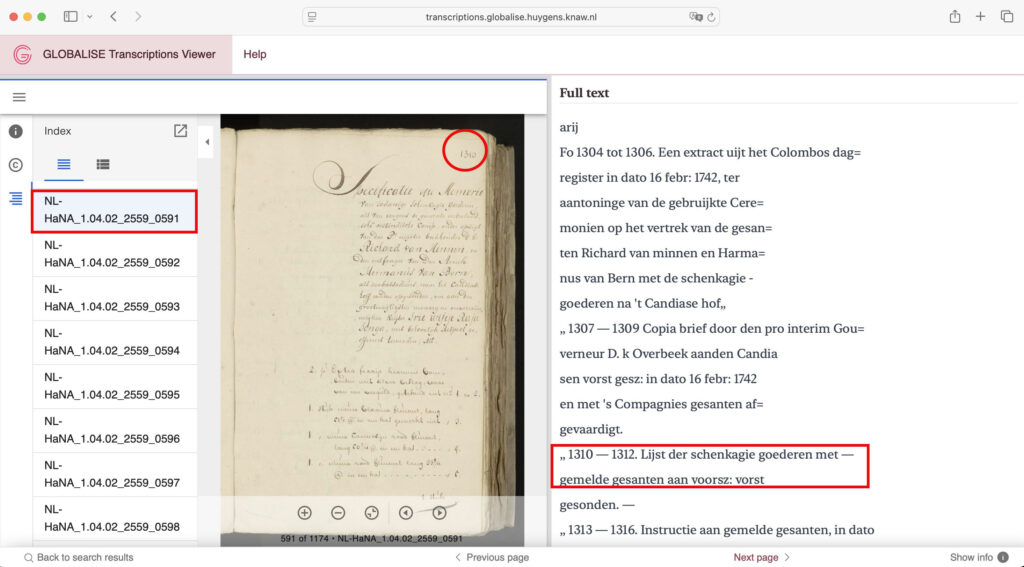
Navigate through this guide: What are you searching for? Cited record | Document type | Event | Location | Person | Object | Keywords | Tips on searching | Further reading
1. Locating an original record cited in secondary literature
If you find references to a VOC record in secondary literature, you may wish to look up its original. The first thing to check is the format of the inventory number. In case the record in referenced using the now-obsolete ARA (Algemene Rijks Archief) inventory number, use the convertor tool to find the corresponding NA 1.04.02 inventory number. This tool provides a concordance between historic ARA numbers and current 1.04.02 numbers.
Next, check whether the record is found within the GLOBALISE corpus. The GLOBALISE corpus only includes NA 1.04.02 inventory numbers 1053-4454 and 7527-11024. In case the inventory number is not within our corpus, scans may be digitally available on Nationaal Archief 1.04.02, search for it using the ‘zoek naar inventarisnummer’ function.
Finding the correct inventory number
As an example, we aim to find a record cited in secondary literature as such: VOC 1136, f. 951v.1 This number (951v) refers to the handwritten number on the original VOC record. A folio or page number is usually not the same as the scan number. By page, we usually mean the physical page of the record. Folio numbers generally mean records are numbered consecutively every two pages. The reverse page is usually unnumbered, and in this example, the folio will be 951 and its reverse 951v. The next physical page with a number will be folio 952. However, VOC records may feature either page numbers or folio numbers, or even a mix of both! The best option is check several pages of each inventory number to determine its pagination.
There are two options to find a specific inventory number. The first option is to use filter by inventory nr. on the Transcriptions Viewer. To browse through the whole volume of an inventory number in order, place an asterisk (*) in the search field. Do not leave this field completely blank! That will result in an error message.
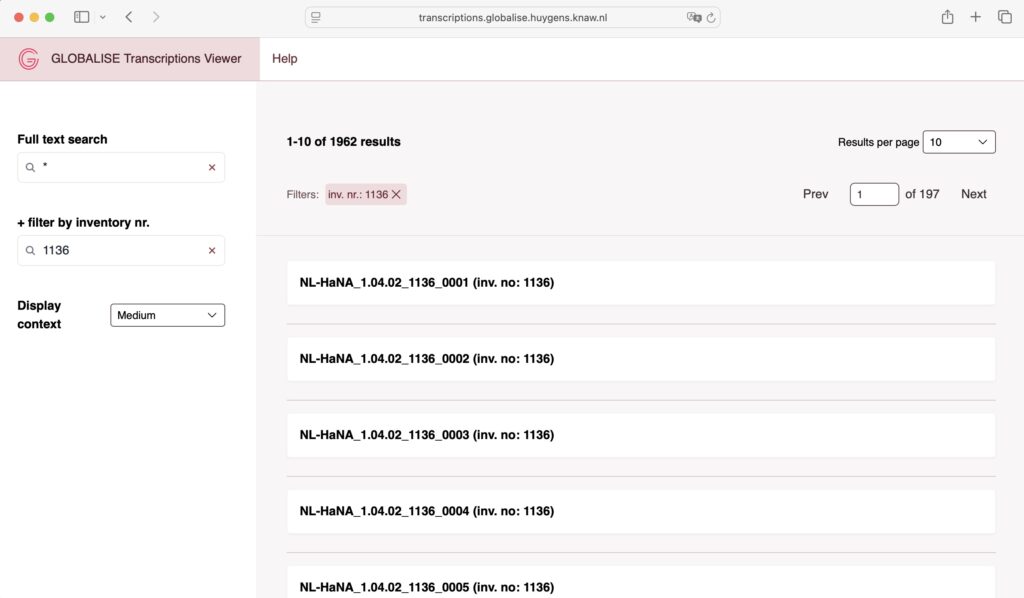
The second option is to download the full-text of inventory number 1136, available from the VOC transcriptions dataset. Enter 1136 into search this dataset. After downloading the full-text document, it is possible to use CTRL or Command + F to search with keywords. These two options are functionally the same. The only difference is that the Transcriptions Viewer searches it online, or while downloading the full-text enables you to search the text locally on your own computer.
Finding the correct scan page
Click on any page in the inventory number, then manually change the scan number in the URL bar. Make sure it is 4 digits. For small numbers, insert additional zeros (eg. 0045). Scan numbers are often double the numeric value of the folio number. Since folio 951 is far into the volume, we can attempt scan number further along, for example 1501. This yields a page with the folio number 785, which is not close enough for our purposes.
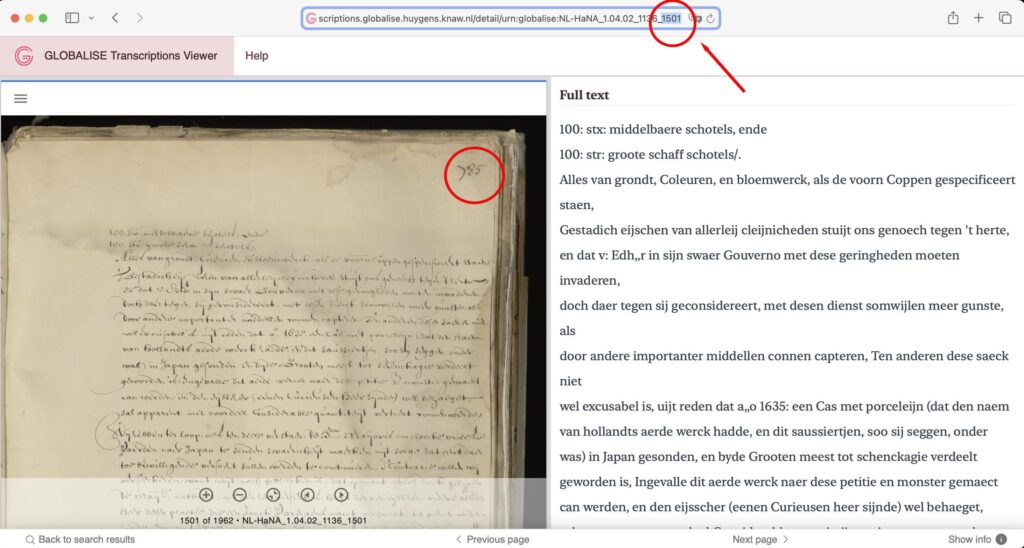
For a second attempt, we can try scan number 1801. This brings us to folio number 902, which is very close to the folio we are looking for.
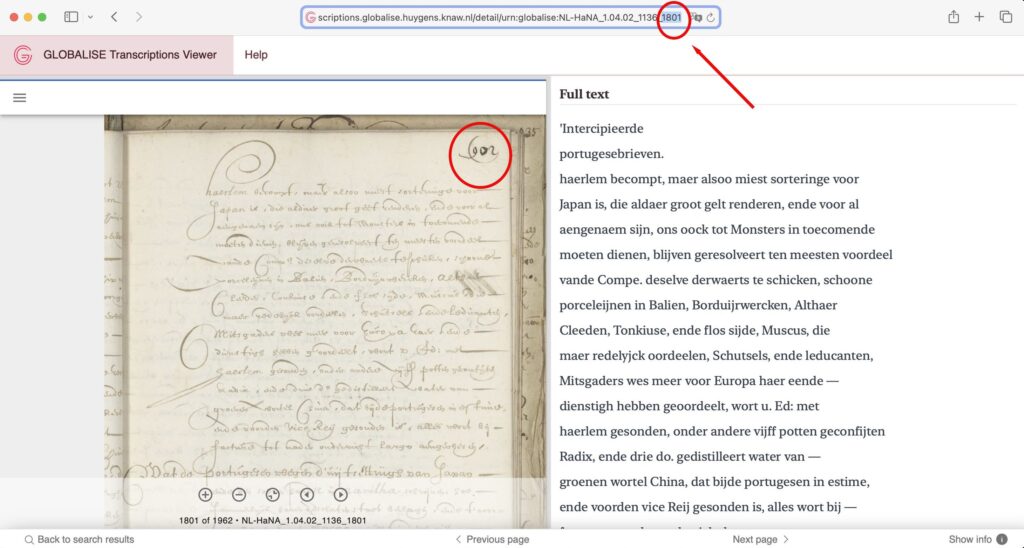
Through this manual trial and error method, we can reach folio 951, corresponding to scan number 1909:
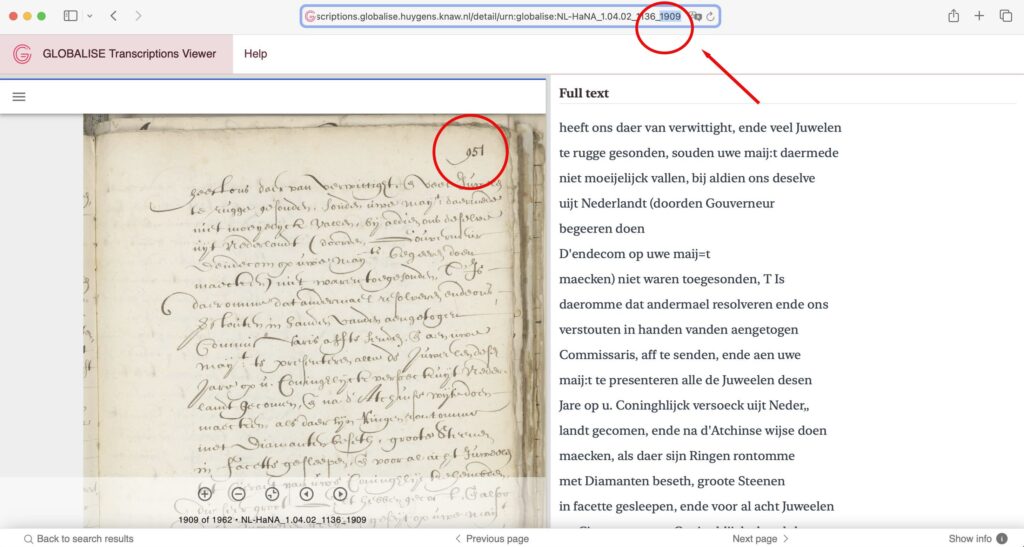
There is no scan page numbered 915v, but this refers to the reverse page after 915. So the citation VOC 1136, f. 951v refers to scan number 1910.
2. Finding a specific type of document
The VOC administrative infrastructure is built around specific types of documents. Each inventory number represents a volume compiled of multiple documents. The former TANAP website had been a conventional entrypoint to the VOC archives for many scholars. Renate Smit writes about TANAP indexes in From ABC to VOC Volume: Utilizing Traditional Finding Aids for the GLOBALISE Infrastructure.
GLOBALISE Docs preserves some of these TANAP resources including PDF lists of available establishment reconstructions.
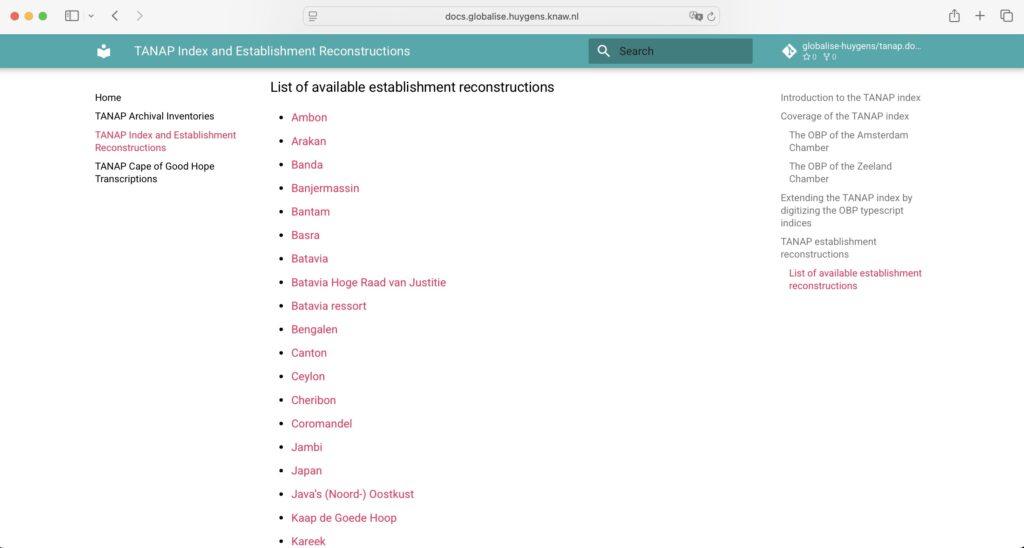
Nationaal Archief Den Haag has made available the VOC: overgekomen brieven en papieren, 1609-1795 index, which works in a similar way to the search function on the former TANAP website. This search looks through titles of VOC records described in the indexes. For example, if you search for ‘coffij’ (coffee), the search yields 85 results. This may seem like a strangely low number. Surely, coffee has been mentioned many more times than this within the VOC records? This just means that coffij appears in titles of 85 VOC records described in these indexes. This does not ascertain how many and which letters may discuss coffee in its contents. With the GLOBALISE Transcriptions Viewer, it is now also possible to search the full-text of VOC records within the GLOBALISE corpus for ‘coffij’ in the contents (query here).
The former TANAP indexes do not fully cover the complete range of the Overgekomen Brieven en Papieren (OBP). GLOBALISE offers an enriched dataset: Digitized Indexes of the Dutch East India Company OBP (1602-1799). This dataset complements the TANAP indexes with new information on inventory numbers 1669-2325; 4374-4447.
Below is an example of a search for a daghregister, or the daily journal. It is possible to use a combination of keywords and geographical location, or keyword and date.
daghregister AND Zeelandia
daghregister AND 1630
A specific date is useful to narrow down the search if you already know from secondary literature that there exists a daily journal on this specific date. Broadening the search date is possible using wildcards.
If you know the decade,
daghregister AND 163*
daghregister AND 164*
If you want to browse either the 17th or 18th century:
daghregister AND 16**
daghregister AND 17**
It is also possible to combine both date and region, for example:
daghregister AND 17** AND colombo
daghregister AND colombo AND 17**
Functionally, the two searches above (whether geography or time is entered first) yield the same number of results.
3. Looking up a historical event
Any historical event is made of up a series of interconnected actions and processes. It is important to first gather contextual information from secondary literature before conducting search queries. Say for example, we are interested in struggles for power between the Dutch and Spanish empires in and around the Philippines. These played out over a series of naval battles over the first half of the 17th century. Key moments included the Battles of Playa Honda (1610, 1617, 1624) and La Naval de Manila (1646), all of which could be understood within the longer duration of the Eighty Years’ War between Spain and Dutch provinces (1566/8-1648). To begin looking for records connected to La Naval de Manila, we could start with searching by location and date of event, in this case using the keywords Manilha AND 1646.
The Transcriptions Viewer only yields 9 results, but these are 9 very promising results. The first search result, inventory number 1160, leads us to a table of contents, which includes reports related to naval battles in and around Manila, dated between March and August 1646. Based on contextual knowledge from secondary literature, this is the correct timeframe for these naval battles.
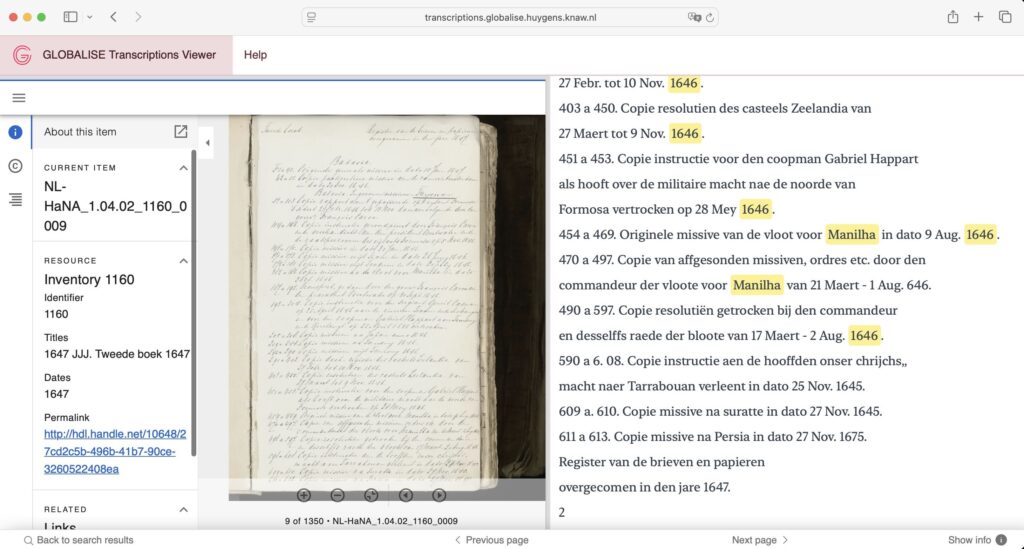
When reviewing search results, take note in which VOC establishment were the events reported. In this case, many reports about events in and around Manila were reported from Batavia. We may surmise that the Batavia section of the OBP would be of most relevance to us. The TANAP lists allows us to search for records which describe Manila in their titles. Make sure to also try out different historical spellings (Manila, Manilha, Manilla). Manila recurs quite often in the category ‘correspondentie met andere Europeanen’. We can choose specific inventory numbers from this list to search through the Transcriptions Viewer. This is only necessary at this point because the Transcriptions Viewer does not yet have more advanced filtering options.
For other types of recurring events, for example embassies to courts, try combinations of ‘gezant’ (the term for ambassador), the geographic location, or the date of the embassy if known. Depending on the region, ‘reis’ or ‘hofreis’ may also yield relevant results.
Finally, aside from searching for historical events according to time, place or key actors involved, the Transcriptions Viewer now also enables searching through event types. Stella Verkijk writes about this approach: ‘Yes okay – but what were they doing? How a lexical approach to event extraction can provide some first answers’. There is a table of event queries at the end of Stella’s post, try it out yourself!
4. Finding a location or polity
When looking for a location or polity, search using known historical spelling(s). For example, a search using the term ‘Manila’ yields 347 results. Even with a wildcard, ‘Manila~’ only yields 903 results. This does not appear correct, given that historically there were substantial trade and shipping connections between Batavia (now Jakarta, Indonesia) and Manila in the Philippines during the VOC period.
After exploring the first few pages of the search results, there is an instance of ‘Manilha’. This turns out to be the more frequent historical spelling used in VOC records. Spellings were not yet standardised in this period. Manila in the archives can be written as ‘Manilha’, ‘Manelhia’ or even ‘Manilla’. The more variations you are aware of and try out, the more expansive your search results will be.
You may find more historical terms in the Early Modern Polities dataset, the Places dataset, or the GLOBALISE geographical indices dataset.
5. Finding a person
Who is who? When searching for a person’s name, note the two possibilities:
1) Variant spellings of names may appear, but they could be referring to the same person.
2) The exact same spelling of a name may refer to two different persons.
One way to verify this is to check the birth and date of the person(s), and the location(s) of their employment or travel route. This background research is very necessary to verify multiple instances of names with the same spelling.
For a more robust search using the Transcriptions Viewer, use a combination of keywords. This could be a combination of profession and date, or profession and geographic location.
It is also important to know historical names of persons as they might have been known at the time.
The Ming loyalist who fought against the VOC in Taiwan with the name Zheng Chenggong (1624-1662) is known more often as Koxinga. In VOC records, his name is often spelled as either Koxinga or Coxinga.
Names of people in the Indonesian archipelago sometimes use the old spelling where the vowel sound ‘u’ is written as ‘oe’. Mentions of Sultan Hasanuddin (1631-1670) of the Sultanate of Gowa can be found using the old spelling ‘Hasanoeddin’. A search for hasanudin~ yields 29 results, while hasanoedin~ yields 145 results.
For Europeans in the early modern period, their names may also appear differently depending on their educational and social background. For example, the VOC physician and botanist Paul Hermann (1646-1695) can be found using the Latin spelling of his name Paulus Hermanus.
Several indexes and datasets provide useful starting points and references when searching for a historical person:
The Namebooks of the Dutch East India Company (1730-1794) is derived from18th century booklets of VOC personnel employment data.
The Overview of People in the TEPC Inventories (1673-1844) dataset provides names in the inventories of deceased people created by the Orphan Chamber of the Cape of Good Hope from 1673-1844.
The 14 volumes of the Generale Missiven series, covering the years 1610-1767, feature an index of persons’ names at the end of every volume.
The Nationaal Archief Den Haag also provides indexes for VOC Opvarenden and Oost-Indische Testamenten.
In case you do not yet have a person’s name to look for, but simply want to start your search by knowing which communities are mentioned in the archives, you can use our Ethnicities, Religious Groups and Castes in the Archives of the Dutch East India Company dataset to find terms that were used to reference some of the communities mentioned in the archives. The dataset mentions which languages the terms are associated with, which may help you to filter your search. The accompanying data documentation includes an introduction to social categories within the context of historical research pertaining to the Dutch East India Company. Kindly read the dataset documentation before you proceed further.
6. Searching for an object
The VOC archives are rich with information about objects, whether as commodities, gifts, personal items, or provisions. When searching for a particular object or material in the Transcriptions Viewer, use wildcards and always think of corresponding or related terms.
For example, a search for parelmoer (mother of pearl) initially only returns 2 results, but a search using parelmoer~ returns 1216 results. Reading up on contemporaneous texts from the early modern period may also shed light on other relevant terms. In the context of shells, Georg Eberhard Rumphius’ D’Amboinsche Rariteitenkamer (1705) provides more names and keywords to search for, even names in local languages. By compiling a search of relevant keywords, such as schelpen~, schulpen~, schaalvis~, hoorntjes~, it is possible to find more results. Of course, more research needs to be done to understand how terms relate to each other, to distinguish between different species of molluscs, or the relationship between materiality of such objects and the living species which they were derived from.
Another useful tool for keyword exploration is the Word2Vec tool. This tool can assist to find keywords that occur in similar contexts within the GLOBALISE corpus. To run this tool online, click on Option One: Open this notebook in Google Colab.
To start, click the play icon, one at a time, from the top of the page. Each cell will display a check mark once it is successfully run. Then continue down the page, clicking the play icon on the next cell below. Once everything is ready, you can insert your own keywords to replace the given examples. Note that it is only possible to search for one word, not multiple words, and it must all be in lowercase. If the tool returns an error when searching a particular keyword, this means that the term does not exist within the GLOBALISE corpus.
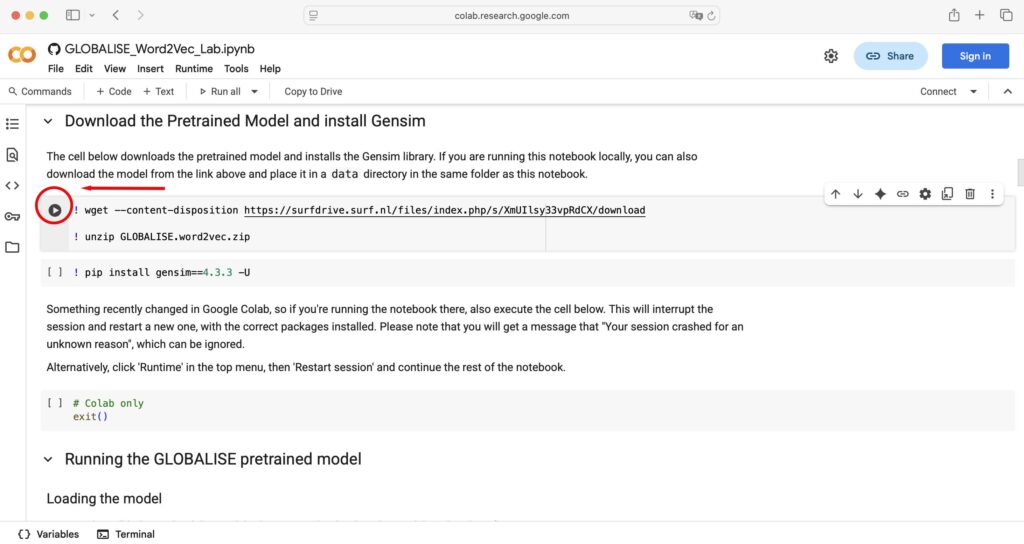
GLOBALISE guest researcher Ann Heylen writes about exploratory searches using the Word2Vec tool, and how this led her down the trail of an unexpected story: Incognito Royalty on the Princes Roijael.
For more inspiration, browse our thesaurus of commodities to explore various objects found in the VOC archives. For textiles, the Dutch Textile Trade Project as well as the Textile Databases provide useful terminology for search queries in the Transcriptions Viewer.
The Book-Keeper General of Batavia database covers 18th-century movement of VOC ships and their cargoes, which can be used to trace the volume of goods and materials transported across different routes.
7. Exploring with contextual keywords
The searchable corpus of GLOBALISE enables us to search phrases and interesting connections to and from the Dutch East India Company. Starting with just one term, it is possible to first contextualise that term, then look up corresponding terms, which leads to new search possibilities. An exploratory example is to search for connections between Batavia and Manila. Using wildcards with Batavia~ and Manilha~, we come across records describing different types of interactions.
For example, a group of people described as ‘Manilase Spaenjaerden’. Who were these people? Using this phrase as a new search query leads to a different archival snippet, which mentions letters to Manila-based Spanish being intercepted by VOC agents. This subsequent phrase, ‘geintercipieerde brieven’, then re-opens up the query to a broader geography, suggesting the information practice of intercepting letters did not just occur between Batavia and Manila, potentially also in other geographic regions where the VOC operated. The searchability of the GLOBALISE corpus allows us to explore the archives by following up trajectories of contextual phrases in this way.
An important point to note when searching phrases, is to always use double quotation marks (“”), or use AND to search phrases with more than one word. By default, the search will conduct an OR query (searching for each individual instance of two or more terms) if you do not use double quotation marks or if you do not use AND. For example, geintercipieerde brieven yields 238582 results (!). This is essentially an OR search query which becomes very numerous because brieven (letters) of course appears very frequently in the VOC records.
However, geintercipieerde AND brieven yields only 112 results. Searching with wildcards again further expands the search: geintercipieerde~ AND brieven~ yields 220 results. We can set the distance of how far the variance from the initial spelling lies. This is known as the Levenshthein distance. The search bar can conduct searches of ~1 or ~2 (there is no ~3!). By default, if there is no number added, any search with a ~ is automatically set to ~2, which gives a broader range of results. To illustrate, geintercipieerde~2 AND brieven~2 yields 220 results, same as the default above, while geintercipieerde~1 AND brieven~1 yields 192 results. Summing up, if you want to use a wildcard to broaden the search query to include variant spellings but still retain a narrower range, use ~1.
8. Tips on searching with historical Dutch terms
This is a suggested workflow on how to conduct a search query in case of minimal Dutch language skills*
1. Use a translation tool of your choice to translate a term from your language to modern Dutch.
2. Insert the modern Dutch word into this semantic dictionary to try and identify relevant historical terms.
3. Additionally, the Word2Vec model may yield further relevant historical keywords for searching.
4. Enter a historical term to start a search query in the Transcriptions Viewer.
5. Translate the transcription back into your preferred language using a translation tool of your choice.
You may also try to enter search terms in other languages (transliterated into the Latin alphabet) into the search field. You may be surprised at what you will find! Aside from Dutch, there are many languages in the VOC archives, even if their numbers within the entirety of the GLOBALISE corpus may be relatively small. Arno Bosse writes more about this in The Languages of GLOBALISE.
Looking through historical dictionaries or wordlists may also prove useful, depending on the research topic:
De Hautman, Frederic. Spraeck ende woord-boeck (Amsterdam,1603/4)
Loderus, Adries. Maleische Woord-boek Sameling (Batavia, 1707).
*This method is a work-around. We would appreciate your feedback and suggestions on what does or does not work for you.
Further reading
The inventory and description of 1.04.02 is on the Nationaal Archief Den Haag website, including an introduction in English by F. S. Gaastra. An overview of archives about the Dutch East India Company is also available.
The thesaurus of commodities, VOC Glossarium, and the historical dictionary are useful references for historical terms.
Datasets are freely accessible and downloadable from the GLOBALISE collection on Dataverse.
Balk, G. L., Van Dijk, F., Kortlang, J., Gaastra, F. S., Niemeijer, H. E., & Koenders, P. (2007). The Archives of the Dutch East India Company (VOC) and the Local Institutions in Batavia (Jakarta) (1st ed.). Brill.
Bogtman, W. Het Nederlandsche handschrift in 1600 (Bogtman: 1933). Available on Delpher.
Sterkenburg, P. G. J. van. Een glossarium van zeventiende-eeuws Nederlands (3rd edition, Groningen: Wolters-Noordhoff, 1981). Print edition only.
Yolanda Spaans, A Practical Dutch Grammar. The English edition is still in print and only available as a printed book. However, downloadable translated editions in other languages are freely available.
Release notes
With thanks to Manjusha Kuruppath, Lodewijk Petram, Kay Pepping and Brecht Nijman for their valuable inputs on the development of this guide. This is an evolving document, as we will improve the functionality of the GLOBALISE Transcriptions Viewer over the coming period and will launch a full-fledged research platform by the end of the GLOBALISE project (December 2026). In the event that an update provides more functionalities or affects how search queries can be conducted, this guide will be updated accordingly.
Contact us
We welcome your feedback and suggestions about using the Transcriptions Viewer through this feedback form.
If you have any further questions or comments about the GLOBALISE project in general, feel free to reach out to us through our contact form.
Disclaimer: This tutorial features links to external resources for reference and further reading. We endeavour to keep these links up-to-date, however we do not take responsibility for the content and security of external websites, kindly make use of these links and tools at your own discretion.
- Sher Banu Khan, Sovereign Women in a Muslim Kingdom: The Sultanahs of Aceh, 1641−1699 (Singapore: National University of Singapore Press, 2017). ↩︎



